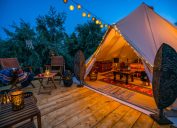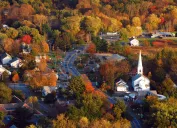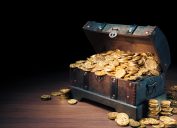The 12 Best National Parks That Need to Be on Your Bucket List
From Acadia to Shenandoah, these national parks are worth a visit this summer.

Believe it or not, summer is right around the corner, meaning it's the perfect time to start planning a vacation to one of the country's 63 stunning national parks.
While each park offers up its own reasons for visiting—whether it's unique wildlife viewing, like seeing the bighorn sheep at Badlands National Park, or a once-in-a-lifetime opportunity, like seeing the lava flowing at Hawai'i Volcanoes National Park—some parks are always going to be more popular than others.
Yellowstone National Park, the first national park in the country and one of the most famous, is an exceedingly popular summer vacation destination, recording a record 4.8 million visitors in 2021. But while you may dream of visiting Yellowstone, there's no shortage of other must-see parks across the country—and we've compiled a list of standouts for you here. Read on for the 12 best national parks that you need to add to your bucket list.
READ THIS NEXT: The 8 Best Off-The-Radar Destinations in the U.S. That Need to Be on Your Bucket List.
1
Carlsbad Caverns National Park (New Mexico)

When you picture a national park, you most likely imagine a mountain range or large open area in the great outdoors. But some of the country's most interesting parks aren't located outdoors at all—instead, they're underground, like New Mexico's Carlsbad Caverns National Park.
The park, located in the Guadalupe Mountains, contains more than 100 different caves.
"The main chamber, appropriately called the Big Room, is the largest cave chamber in North America by volume, approximately four thousand feet long, 625 feet wide, and 255 feet high at its tallest point," says Alex Tiffany, a travel planner and blogger at Just Go Exploring. "The caverns contain thousands of stalactites and stalagmites, some of which are over 60 feet tall."
The caves aren't the only reasons travelers make the trek out to southern New Mexico: The park also has a free Bat Flight Program where visitors can watch bats take to the skies every night at sundown.
2
New River Gorge National Park (West Virginia)
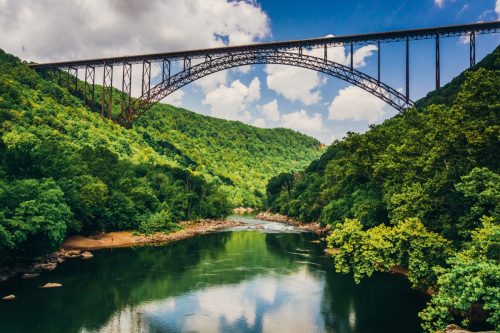
While it's named for the New River that runs through the park, the New River Gorge National Park is also aptly named because it's the country's newest national park and the state of West Virginia's first. The park, which doesn't charge an entrance fee, covers 70,000 acres of the Appalachian Mountains and is a great base for taking part in activities like whitewater rafting and hiking.
"[The park is] steeped in rich history and outdoor recreation, including hiking, mountain biking, rock climbing, and whitewater rafting," says Chelsea Ruby, cabinet secretary of the West Virginia Department of Tourism.
New River Gorge National Park was re-designated from a national river to a national park in 2021, and it features regular guided hikes along the river led by park rangers.
"The park also encompasses the New River, which is one of the oldest rivers on the continent, and the world's third longest single span arch bridge, spanning 3,030 feet and sitting 876 above the New River Gorge—making it the second highest vehicular bridge in the world," says Ruby. "You can even walk across the catwalk beneath the bridge, which takes you 1.25 miles from one end to the other."
READ THIS NEXT: The 10 Best Weekend Trips You Need to Take This Year.
3
Virgin Islands National Park (U.S. Virgin Islands)
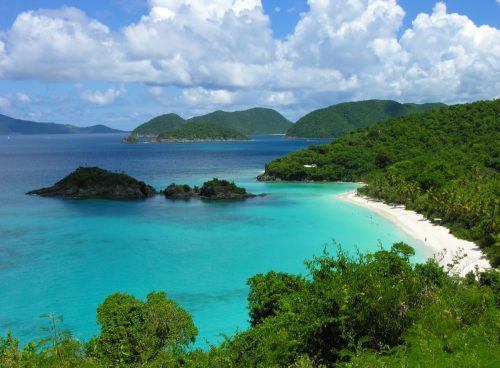
Interested in taking a tropical beach vacation, but not looking to splurge on international airfare? Consider a trip to Virgin Islands National Park, which is located on the U.S. Virgin Islands in the Caribbean Sea.
"Encompassing more than half of the island of St. John in the U.S. Virgin Islands, you can relax on some of the best beaches in the world," says Kristin Young, of the travel website Snorkel and Hike.
A trip to Virgin Islands National Park isn't just a day on the beach. Well, it can be—but it can also be so much more, as the park offers boating, snorkeling, and ancient sites. It's also one of the lesser-frequented and more underrated parks, with around only 304,000 visitors in 2018, given that it's a bit trickier to travel to than some of the mainland parks.
"It will require a bit more work to get there, as you'll need to fly to St. Thomas and then take a ferry to St. John, but it's worth the effort for such a unique national park experience," Young says.
4
Yosemite National Park (California)

One of the most famous national parks, Yosemite definitely deserves a place on everyone's bucket list, according to Adam Marland, travel photographer and blogger for We Dream of Travel.
"Yosemite National Park is arguably the most iconic park in the entire country," Marland tells Best Life. "With its granite cliffs, picturesque rivers, thundering waterfalls, and abundant wildlife, this natural wonderland is largely responsible for the progression of the entire art of landscape photography having inspired some of Ansel Adams' greatest works."
There are different ways to explore Yosemite, Marland adds, but no matter what's on your agenda, you won't be disappointed.
"Whether that visit is a one-day whistle-stop itinerary packed with idyllic roadside vistas or extended exploration of its endless beauty, you are sure to leave nothing short of inspired," Marland says of the California park.
READ THIS NEXT: The 12 Best Mountain Towns in the U.S.
5
Biscayne National Park (Florida)
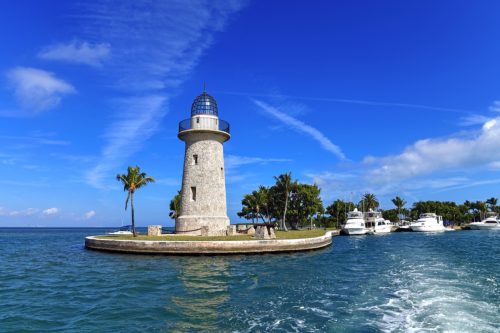
There's something about the Florida Keys that makes it feel like a different world. There's also something about Biscayne National Park, located in the Keys, that helps it stand out from the rest of the country's parks: It's almost entirely underwater.
Approximately 95 percent of the park is set out on the water, offering the opportunity to explore coral reefs, kayak, or partake in a guided tour of shipwrecks.
"Biscayne Bay is a marine sanctuary home to manatees, turtles, exotic fish, and shipwrecks," says Kacy Matthews of K. Sutherland PR, a firm that focuses on travel and lifestyle.
One of the reasons that the park is underrated is because it can be a little tricky to get to, but Matthews says that the park is quickly becoming more accessible.
"The drive to the park can be a little taxing, but Biscayne National Park Institute offers a new Coconut Grove Snorkel Adventure that picks visitors up from Dinner Key Marina and takes them through the bay and right into [the park]," Matthews says.
6
Lassen Volcanic National Park (California)

One of California's nine national parks, Lassen Volcanic National Park, not far from Redding, is one of the most unique locations in the country. The park's star features are its volcanoes, and it's the only place in the world where all four types of volcanoes (shield, plug dome, cinder cone, and composite) are visible.
"Lassen Volcanic National Park boasts incredible mountain scenery reminiscent of Yosemite, as well as fascinating thermal wonders similar to Yellowstone with just a small fraction of the visitors," says Nicole Ayllon, a destination marketer at Development Counsellors International.
During the summer, the park isn't just great for exploring during the day—it has a ranger-led Starry Night program and an annual Dark Sky Festival, a three-day event filled with stargazing and astronomy activities.
"Although Lassen Park is open year-round, access is usually limited from December to May," Ayllon says. "Excellent cross-country skiing is available, as well as interpretive snowshoe tours led by park rangers. During the warm summer months in Redding, enjoy hiking, stargazing, biking, swimming, and more."
READ THIS NEXT: The 10 Most Naturally Beautiful States in the U.S., New Data Shows.
7
Grand Canyon National Park (Arizona)

Another iconic, must-see park is (of course) the Grand Canyon in Arizona. Perhaps you've dreamed of seeing it since you were a kid, or maybe it's a new addition to your travel bucket list—either way, experts say you really can't go wrong at this national park.
"No national park bucket list could be considered legitimate without inclusion of one of the Seven Natural Wonders of the World!" Sophie Clapton, travel blogger for We Dream of Travel, tells Best Life.
The sights will take your breath away, according to Clapton, guaranteeing memories for years to come.
"Grand Canyon National Park is said to be one of the most emotion-inducing natural sights in all of the world," Clapton says. "The true scope of this endless expanse of time-carved landscapes makes it hard to appreciate its grandeur in a mere photograph. It is a place that can not truly be known through images or videos—it must be felt to be experienced."
8
Crater Lake National Park (Oregon)

Located in Oregon's Cascade Mountains, Crater Lake National Park is named for exactly what it sounds like: a nearly 2,000-foot-deep lake formed in the crater left after a volcanic explosion. The water is extraordinarily clear because there are no rivers flowing into or out of it.
"Seven millennia of rain and snowmelt have filled the crater, which has resulted in one of the world's clearest bodies of water," says Emele Hibdon, a public relations representative for Travel Southern Oregon. "Scientists have measured the water's clarity to as deep as 120 feet."
While you can sit and be memorized by the crystal-clear water all day, there's also an abundance of other activities to take part in, like hiking and wildlife viewing. Or, if you prefer to drive, take a venture out on Rim Drive, a road that circles the lake and has more than 25 overlooks.
"Crater Lake National Park has 183,224 acres of mountains, peaks, old-growth forests, volcanic fumaroles, two waterfalls, and the lake," Hibdon says. "The ranging elevations throughout the park provide diverse habitats for an array of wildlife and make for an outstanding outdoor laboratory and classroom."
READ THIS NEXT: 13 Small U.S. Towns That Feel Like the Wild West.
9
Kenai Fjords National Park (Alaska)

If you're looking for a Game of Thrones sort of setting with fields of ice, sharp mountain peaks, and a vast ocean, then look no further than Kenai Fjords National Park, home to approximately 35 named glaciers.
"Kenai Fjords National Park in south-central Alaska offers an incredible mix of both land- and water-based activities," says Gaby Pilson, outdoor educator and climbing instructor, of The Geeky Camper blog. "In Kenai Fjords, you can hike to the bottom of a massive glacier, trek to the edge of the largest icefield that's wholly contained within the U.S., and take boat tours out to see orcas, humpback whales, and Steller's sea lions."
The park is one of Alaska's eight national parks; it trails California by one for the title of most national parks in an individual state. Compared to some of Alaska's other parks, Kenai Fjords, located just outside of Seward, Alaska, is one of the more accessible sites.
"It's relatively easy to get to as far as Alaskan parks go," Pilson says. "There's a road that leads right to it from the city of Seward, and you can take boat tours out of Seward, too."
10
Rocky Mountain National Park (Colorado)

By far, the most popular national park in the Rocky Mountains is Yellowstone National Park, but head a bit further south down the range and you'll run into the 415 square miles of Rocky Mountain National Park, located just outside of Estes Park, Colorado.
One of the highlights of the park is that it includes something for every traveler, according to Steve Warren of Maps Over Coffee.
"The adventurous backpacker could hike for weeks at a time on new trails, the rock climber will find some challenging routes, those with limited mobility will find accessible trails, and families will find wildlife and ice cream nearby," Warren says, adding that the park's proximity to the town of Estes Park makes it easy to find a hotel to stay in and a restaurant to visit.
Wildlife viewing is also one of the perks of visiting the park (which is about a 90-minute drive from Denver), as bighorn sheep make appearances throughout the summer, and elk and moose can be seen all year round.
For more travel advice delivered straight to your inbox, sign up for our daily newsletter.
11
Shenandoah National Park (Virginia)

It's only 75 miles away from Washington, D.C., but the peacefulness of Shenandoah National Park feels like it's a world away from the nation's capital. The park, located in Virginia's Blue Ridge Mountains, has more than 500 miles of trails for hikers of all levels.
"Nestled between Shenandoah Valley and the Piedmont region, this land is bursting with cascading waterfalls, diverse flora and fauna, and breezy summits," says Barbie Mission, a travel research analyst at Trip 101. "It also has mountains with unique formations towering over 4,000 feet high. With peaceful wooded valleys, kid-friendly hiking trails, and swimming holes, it's a great place to visit, especially for families."
The park is also home to a stretch of the Appalachian Trail, so you can either make your way there to do a day hike or arrive and hike through the park for days with other travelers. If you don't feel like hiking too extensively, you can also take a drive through the park.
"One thing that sets this slice of heaven apart from other parks is Skyline Drive, the only public road running through the park," Mission says. "This scenic byway offers several overlooks, including Range View and Spitler Knoll where visitors can enjoy breathtaking views of nature."
12
Acadia National Park (Maine)
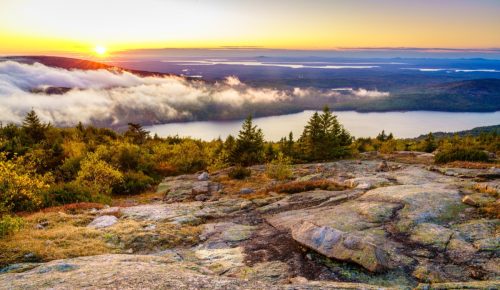
There are a lot of firsts associated with Acadia National Park. It's the first park alphabetically, the first (and only) park in New England, and one of the first places the sun rises in the country, making it an ideal spot for travelers who love to watch sunrises in extraordinarily beautiful settings.
"One of the best sunrise spots can be found here in Acadia, on top of Cadillac Mountain," says Samantha Hamilton, creator and writer behind New England Wanderlust. "It's actually one of the very first places to see the sun rise over the horizon each morning in the entire U.S., and you can either hike to the summit, or drive the auto road up for an easier, more carefree experience."
Hamilton recommends visiting the park in the autumn to see the leaves as they change color (something the area is famous for) and avoid much of the summer crowds that pack the park each year.
"The con of visiting Acadia National Park is that during the summer, it's incredibly busy," Hamilton says. "New Englanders live for the summer season after a cold winter and potentially rainy and cold spring season. Prices will be at their highest in the summer for accommodation, and the park will be at its most crowded."
Conveniently, the park is open year-round and is ranked as the third-best place in the world to visit during October by U.S. News & World Report.
- Source: https://www.nps.gov/yell/learn/news/22003.htm
- Source: https://www.nps.gov/cave/index.htm
- Source: https://www.nps.gov/cave/planyourvisit/bat_flight_program.htm
- Source: https://www.nps.gov/neri/index.htm
- Source: https://www.nps.gov/viis/learn/news/tourism-to-vi-national-park.htm
- Source: https://www.nps.gov/bisc/index.htm
- Source: https://www.nps.gov/lavo/planyourvisit/stargazing.htm
- Source: https://www.nps.gov/lavo/planyourvisit/dark-sky.htm
- Source: https://www.nps.gov/kefj/index.htm
- Source: https://www.nps.gov/shen/index.htm


